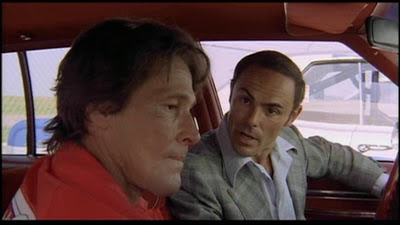After establishing himself as a skilled low-budget horror
craftsman with Shivers (1975) and Rabid (1977), David Cronenberg took a
surprising turn with his third professional feature. Fast
Company (1979) is a drag racing exploitation film following the conflict
between a star driver (William Smith) and his sleazy manager (John Saxon). There isn’t much more to the story than
that. The film packs in all of the
expected racing film requirements (copious racing footage, gratuitous nudity,
John Saxon) but lacks any of the elements that set the best exploitation films
apart from the pack (subversive political statements, offbeat humor, edgy
content). Fast Company is an utterly generic little movie that isn’t notable
as a standalone film or even recognizable as a Cronenberg project.
The Brood (1979),
on the other hand, is about as Cronenbergian as a movie could possibly be. The action develops around the Somafree
Institute, where psychotherapist Hal Raglan (Oliver Reed) has developed a
technique called “psychoplasmics” that allows patients with mental problems to
release their suppressed emotions through physiological changes in their
body. Raglan’s prize patient is Nola
(Samantha Eggar), a former victim of child abuse who is currently locked in a
custody battle with her estranged husband Frank (Art Hindle). After discovering some disturbing marks on
his daughter’s body, Frank becomes increasingly determined to invalidate
Raglan’s work and gain custody of his daughter.
As Frank gets closer to discovering the truth behind Somafree’s
research, people sympathetic to his struggles are murdered by strange,
dwarf-like children that resemble Frank and Nola’s daughter. It is eventually revealed that these are the
psychoplasmic offspring of Nola, who target the sources of Nola’s rage (her
abusive mother and neglectful father, a teacher who she mistakenly thinks is
sleeping with Frank, etc.).
The sci-fi plot is ultimately as silly as it sounds, but the
violence is presented in such a matter of fact way that the film takes on a
genuine air of menace. Shivers and Rabid were both gross and creepy, and perhaps a bit unnerving in
their best moments, but The Brood is
outright disturbing. The climactic scene
revealing Nola’s psychoplasmic condition is one of the most revolting and
fucked-up things I’ve ever witnessed in a piece of entertainment, but
Cronenberg’s willingness to go as far as he does gives the film distinction and
power. I generally subscribe to the old
Val Lewton idea that what is unseen and suggested is scarier than anything that
is shown, but Cronenberg is using viscera and gore here to create images that we
couldn’t imagine. Frank’s disgust with
his wife’s physical and mental state is palpable only because we are allowed to
see what he sees.
In many respects The
Brood is Cronenberg’s most accomplished film up to this point, but it is
also certainly his least pleasant. The
filmmaking is smoother overall than in Cronenberg’s earlier horror films –
perhaps owing to the director’s discovery of several crewmembers that would go
on to be regulars in his staff, such as cinematographer Mark Irwin and editor
Ronald Sanders, both of whom first worked with Cronenberg on Fast Company – and the cast is stronger
overall than in Shivers or Rabid.
For a movie with such a goofy plot, The
Brood isn’t much fun; the film seems to have been an outlet for Cronenberg
to take out his frustrations with his real life custody battle and divorce settlements
with his first wife, which were ongoing as the film was made. But it is a powerful, genuinely scary film,
and Cronenberg’s most advanced look at the collision of psychology and biology
up to this point.
UP NEXT Scanners and Videodrome


No comments:
Post a Comment